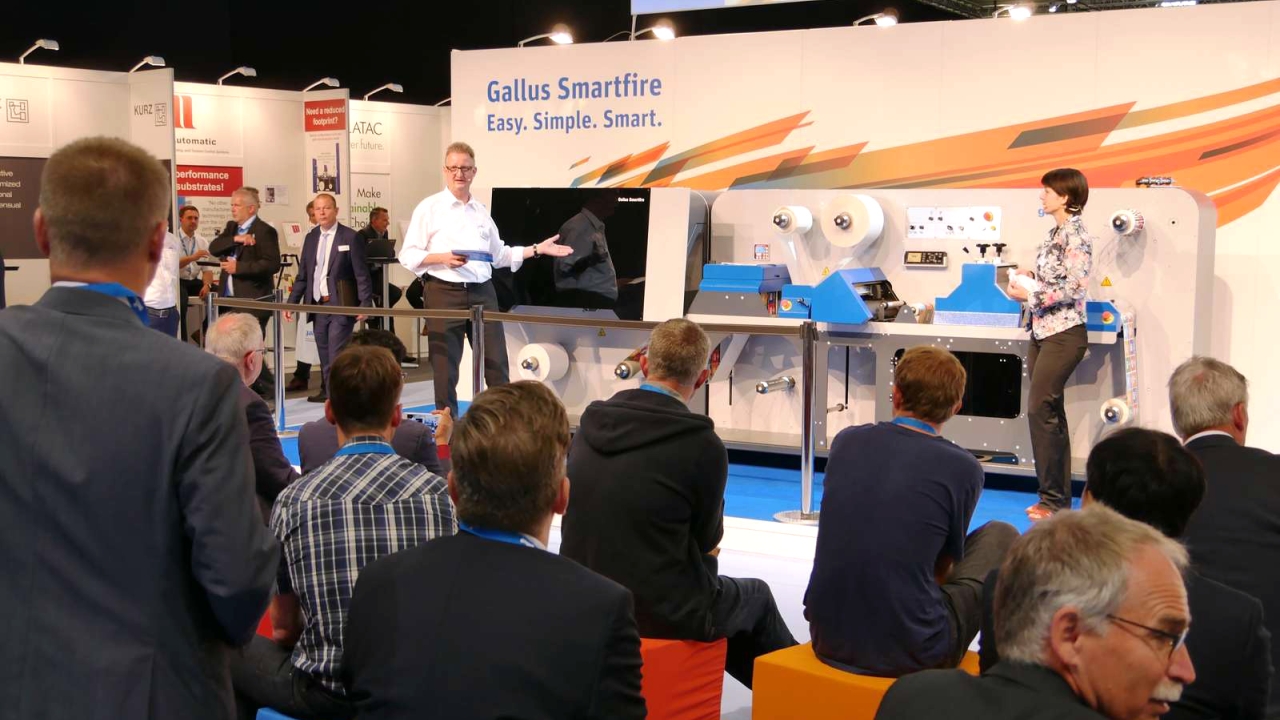Gallus launches entry-level digital press

Gallus has launched a Memjet-powered entry-level inkjet press targeted at commercial printers looking to diversify into labels, brand owners looking for an in-house on-demand label print facility, and label converters looking to enter the digital market or complement production-scale digital presses.
‘With the Gallus Smartfire we are focusing on new target groups who are looking for a smart entry into digital label printing,’ says Michael Ring, head of Digital Solutions at Gallus. ‘The Memjet technology allows us to offer an inkjet printing press that produces labels with a quality of 1600 x 1600 DPI while still keeping the investment costs at a low level.’
As a water-based press, the Gallus Smartfire is intended to fit into non-industrial environments. It is VOC-free, with no requirement for venting and is powered from a single standard electrical power supply. Ring says that water-based inks allow the press to produce ‘food-compliant labels with no additional top coating barrier.’
The Smartfire uses 4-color (CMYK) Memjet inkjet heads imaging at the standard Memjet print resolution of 1600 x 1600 DPI at line speeds up to 9m/min on a 240mm web width. The digital front end (DFE) is driven by a Caldera Grand RIP and the press ships with a preinstalled package of hardware and software. The software tools are targeted at novice users and include color management, substrate calibration, pre-flight, step and repeat, and variable data print (VDP) and cost calculation modules.
The press incorporates in-line finishing, including self-wound lamination and die-cutting – either digitally with an integrated plotting knife, or by a semi-rotary die-cutter. The line is completed with matrix pick-up, slitter and rewinding.
Given its target market, Gallus says the Smartfire is designed for ease of use and minimum waste between jobs. The ink containers are easily replaceable and inkjet heads can be quickly swapped out.
The press is expected to sell for under 150,000 euros with an ink cost of under 207 euros/liter.
Gallus is taking a phased approach to the rollout of the Smartfire, starting with early customer acceptance testing at 2-3 sites in July, firstly in Europe and then the US. The first customer shipments should take place from September. As well as the Smartfire introduction, Gallus made a further important digital announcement concerning its Labelfire hybrid press (based on the ECS340 flexo press platform).
New is an integrated screen printing unit on the upstream end of the press, which will be particularly beneficial for high opacity first down whites when printing on clear film or metallics. On the converting end of the press, Gallus announced the commercial availability of the new Digital Embellishment Unit previewed in beta mode at Labelexpo Europe last year. The DEU is capable of applying matt and gloss effects, spot coatings, metallic reliefs and tactile effects. Particularly effective is the combination of metallic foil and haptic/3D effects.
Heidelberg partner
With Gallus now fully owned by Heidelberg, its recent Innovation Days event presented an interesting opportunity to see where the narrow web specialist fits into the wider Heidelberg portfolio and strategy.
Stephan Plenz, head of Heidelberg’s Digital Technology Segment, placed the SmartFire firmly into the context of Heidelberg’s transformation into a digitally-focused company – a transformation still under way.
He noted this change is taking place at all levels in the company – technology, organization and culture, and is already responsible for turning around Heidelberg’s fortunes. Net sales of the Heidelberg group in 2017-2018 are on target for 2.4bn euros, a net profit of 14m euros. Mid-term targets are to greatly increase profitability as well as turnover, with targets for 2022 set at 3bn euros of sales with a 100m euro profit margin.
Plentz looked at the changing face of the press market. With the increased utilization of installed equipment there will be a declining number of offset printing units sold, while digital and flexo increase their overall share of the market.
Plentz showed that label press print volume increased by 3.4 percent between 2016 and 2019, and by another 3.4 percent from 2019 to 2022, against an overall market growth of 0.6 percent and 0.8 percent respectively. At the same time packaging press print increases by 2.7 and 2.6 percent. The commercial segment decreases by between 0.1 and 0.2 percent over this period.
Heidelberg aims to counter stagnant growth trends in the sheet-fed offset market – which includes wet-glue label printers of course – by continued development of its ‘Smart Print Shop’ concept. Smart Print Shop is based around Heidelberg’s Prinect Business and Production modules which integrate equipment, consumables, service and the end customer.
In digital print, Heidelberg sees packaging as the biggest growth opportunity, hence its heavy support for Gallus’ Labelfire press, the latest addition to Heidelberg’s ‘Fire’ series which includes the Primefire (commercial sheet-fed), Versafire (document) and Omnifire (direct-to-shape).
Plentz said Heidelberg is focusing heavily on Cloud-based ‘Smart Services’. With more than 11,000 machines and 25,000 Prinect modules connected, the it is using Big Data processing to provide the base for its Predictive Monitoring and Performance Plus programs, accessed via the Heidelberg Assistant.
Assistant delivers expert know-how and information about availability and performance of presses, and this is now available for Gallus press customers. Assistant also matches consumables and service parts to a converter’s press inventory.
A related offering now available to Gallus press users is mCall, which enables automated generation of service tickets, with the printing press independently communicating all relevant machine data to the Gallus helpdesk. This does away with the telephone calls and emails otherwise required to log a service case.
Label market
Christof Naier, head of Gallus’ label business unit, reinforced the importance of the Heidelberg connection. Gallus sales and service units are now almost fully integrated into Heidelberg’s global service structure and Gallus has access to Heidelberg’s research and innovation network, said Naier.
Naier looked at overall industry trends to explain why Heidelberg sees Gallus as such a valuable asset – it gives Heidelberg increased access to one of the few segments of the print market which continues to grow.
Based on AWA consultancy statistics, Naier said estimated total global demand for labels stands at 59.331 million sqm, 25 percent of which is in Europe, with an expected growth rate of 4.5-5 percent a year.
Gallus’ core business is in self-adhesive labels, which represents around 40 percent of global demand, growing at around 4 percent. But within the labels and narrow web flexibles segment, in-mold is showing growth rates of 6 percent and tube laminate 7 percent, albeit from a relatively low base.
There is an interesting crossover between narrow web and sheet-fed here, since Heidelberg already has a strong presence in the in-mold market through its sheet-fed offset division. And Heidelberg’s sheet-fed division remains a principle player in the wet-glue market, which still accounts for over one third of global label demand. Although wet-glue market share is declining in the face of PS and shrink sleeve label growth, this market segment is still growing at 2 percent per year.
Wraparound and sleeve labels are meanwhile growing at around 4 percent/year with an 18 percent market share (this figure should be treated with some caution, since individual sleeve labels generally have a larger format size than PS).
Naier considered the position of digital labels in this mix, quoting research from Finat and Smithers Pira showing digitally printed labels now represent 10 percent of the label business by value. ‘Inkjet printing is expected to grow faster than EP (electrophotography) because of its greater potential for development,’ he said.
Stay up to date
Subscribe to the free Label News newsletter and receive the latest content every week. We'll never share your email address.


